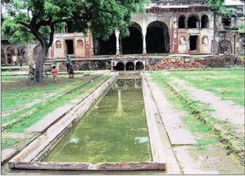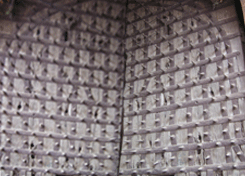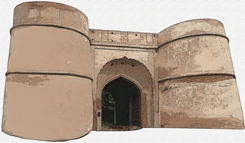|
|
|
|
|
A Brief introduction to the town Farrukh Nagar, Gurgaon
|
|
| Farrukh Nagar, 20 miles south of Delhi, was ruled by the Baloch dynasty before it was captured by the Mughals in the 17th century. It was christened after the Mughal ruler Farrukh Shah who built the Sheesh Mahal in 1711 A.D. The Mughals brought with them the tasteful elegance and grandeur that so characterised their art and architecture. This coupled with the post - Mughal style typifies the monuments and many buildings that align the main bazaar of the town. The Sheesh Mahal is one such monument located in the heart of the busy marketplace, its quiet presence bearing silent witness to its rich past. |
|
|
The town's turbulent history wreaked havoc upon most of its historic buildings including the Sheesh Mahal, Delhi Gate and the Jama Masjid. Most of them changed ownership quite frequently till about 1967 when they were brought under the Municipal Corporation. In fact, the Mahal was in use during the first war of independence in 1857. The Sheesh Mahal is constructed with an abundant use of red sandstone, Mughal bricks and Jhajjar stone, used commonly in the buildings of the period in the district. There is a large courtyard in the front, entered through an arched opening. This was
|

Sheesh Mahal Farrukh Nagar
|
| initially planned as a 'baradari' and was used as the office of the Nagar Palika. The courtyard had a water channel network that connected to a nearby BAOLI (stepwell). |
What really catches a visitor's eye is the extensive decorative element: cusped arches with intricate foliage patterns, decorative brackets, long slender columns with floral patterns and the mirror inlay in the front hall. And as if on cue, a lone chattri standing at the town's entrance, beckons the weary traveler to rest in its quiet and cool chamber. Built about 165 years ago by an illustrious seth (merchant) the two-storeyed chattri was at one time a private residence and even had rooms on the outside.
|

Gate of Dilli Darwaza Farrukh Nagar
|
|
The chattri has a cusp arched opening making the interior well lit and airy: it was thus used as a hawa mahal. The walls are finished with lime plaster and polished to give a marble like finish that gleams by day and night. There are eight arched openings on each floor and floral decorative motifs are used decoratively. However, the one feature of the chattri that makes it of monumental importance is the colourful chitrakala depicting the life of Lord Krishna on the ceiling. In typical Mughal style the paintings add vibrancy to the entire structure. A vibrancy and regality that may soon be lost in time given the condition of the monument. Due to lack of maintenance and negligence the structure is surrounded with weeds. more...
|

Dilli Darwaza Farrukh Nagar
|
|
|
|
|
|
Farrukh Nagar is a small town in the Delhi NCR region which falls in the state of Haryana, District Gurgaon situated about 20 KM in Gurgaon, named after the Mughal ruler Farrukh Siyer. The town was founded by commander Dalel Khan who later changed his name to Mohammad Faujdar Khan, near erstwhile town Khurampur and named it Farrukhnagar. In 1734 AD Faujdar became Nawab of Farrukhnagar by blessing from the Mugal Bhadshah. The town was made in the times of Shershah Suri. The town boasts of Sheesh Mahal, Jama Masjid, Mitrsen ki Bawdi, Sethani ki Hawli and Chattri. In the various direction of the town have five big enternace gate call Gangi Dawaraje out of which Dili Darwaja is still there.
In year 1757 king of Bharatpur attacked and owns this town. The king of Bharatpur ruled this town for seven years later Chief Minister of Mugal empire Gajiuddin got it back to Nawab. Nawab participated in 1857 revolt and because of this town was merge into Gurgaon. Before the revolt the town was with Ahmad Ali Khan who was from the family of Faujdar Khan. Later on was passed on to the Captain Tafjalus Hussain Khan Khor Khai. His son Mahmbat Sharauddin Haider Khan later on became the jaggirdar. That time town used to produce laksh ton of salt. The Govt. used to get 13 lakhs ruppes as income from here. Because of large scale of salt production town was linked to railway station. |
|
|
| © farrukhnagar.com |
Design & Developed by |
|
|
|
|
|